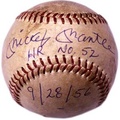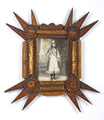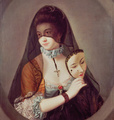This article notes the four major families that produced silver in 18th-century Boston (The Edwards, Reveres, Hurds, and Burts), focusing primarily on the lives and crafts of John and Benjamin Burt. It originally appeared in the August 1940 issue of American Collector magazine, a publication which ran from 1933-1948 and served antique collectors and dealers.
According to present-day standards, 18th-Century Boston was never more than a good-sized village. In 1700, it had an estimated population of 7,000; by 1800 it had multiplied only a little over three and a half times. But accomplishment and importance are not necessarily measured by mass population, as this thriving commercial center on the Massachusetts Bay proved.

Sauce Boat by Benjamin Burt: This was made in 1770 for Nathan and Rebecca Peirce and shows his work in the classic manner.
Many books have been written about what took place there from the close of the 17th Century through the period of the War of 1812, and undoubtedly more will be produced as contemporary records are restudied and others discovered in historical collections.
It is well known that fine craftsmen working there found enough clients, able and willing to buy their products, so that many of them in turn also accumulated fair competencies. Of these, the makers of silver plate were very real evidence of the prosperity and leadership of 18th-Century Boston.
In the impressive lists of its silversmiths of this period, one finds families, members of which followed this precious-metalworking craft for two and sometimes three generations. Like their fellow craftsmen, they were versatile and changed their style and design with the times, but by continuity and high standards of workmanship, four families at least dominated Boston silver-making for the entire century. These were the Edwards, Reveres, Hurds, and Burts.
Three generations of Edwards followed the silversmithing craft. The first of them, John Edwards (1671-1746), was English born and may have served part of his apprenticeship before he reached Boston in 1688. He was followed by two sons, Thomas (1701-1755), and Samuel (1705-1762), and a grandson Joseph, Jr., (1737-1783).

Benjamin Burt Tankard: This was made in 1793 for Captain John D. Wolf whose cypher decorated the front of the tankard framed in a bright cut circular frame.
In the Revere family there was first, the Huguenot-born Apollos Rivoire who was apprenticed to John Coney in 1702, changed his name to Paul Revere, and died in 1754. He had two sons, Paul II (1735-1818), silversmith, patriot, engraver, brass founder, and industrialist, and Thomas (1739-1817), whose work is comparatively little known; and a grandson, Thomas III, who seems to have restricted his silvermaking largely to buckles and spoons.
Some twenty years short of the century mark was the span of the Hurd family with the senior member, Jacob (1702-1758), and his two sons, Nathaniel (1729-1777), and Benjamin (1739-1781). Daniel Henchman (1730-1775) might well be included in this family group since he was an apprentice of Jacob Hurd and married the latter’s daughter.
With the Burt family, although the combined life span of its silversmithing members appears no longer than that of the Edwards or the Reveres, actual working years and number of pieces produced combine to make it one of the most prominent of families working in this craft. First, there was John Burt (1692/3-1745).

Candlesticks by John Burt: These were given to Nicholas Sever by his students in 1724 and presented to Harvard many years ago by a descendent.
He had three sons, all of whom presumably served their apprenticeships under their father. They were Samuel (1724-1754), William (1726-1751), and Benjamin (1729-1805). But the two older sons died only a few years after becoming craftsmen in their own right; consequently, pieces bearing their mark are found only infrequently. John’s youngest son, Benjamin, on the contrary, lived to be seventy-six years old. Allowing for the time he was an apprentice and journeyman under his father, he was a Boston silversmith for between fifty and fifty-five years, working down to the very end of his life. This long span is also borne out by the number of fine pieces bearing his mark that have survived and are known to collectors today.
John Burt died at the early age of fifty-two, but so large a group of pieces bearing one of his three marks are still extant that obviously during his active years as a craftsman he must have been one of the important men of the silver trade in Boston to whom residents there, and in other New England towns, turned when they wished to place a commission for important pieces of church or domestic silver.
Taking into consideration that John Burt was probably apprenticed when about twelve years of age and established himself as a craftsman with his own mark at about twenty-one, this means that for approximately ninety years the Burt family played an active part in silvermaking in Boston. Certainly the large number of pieces bearing their marks is a clear witness of prolific production.

Teapot for Nicholas Sever: This bears the mark of John Burt and the inscription "Ex Dono Pupillorum, 1728."
Except for their silver, they left few records behind them, and as a result biographical data regarding them is meager indeed. Possibly John and his youngest son, Benjamin, were too busy filling orders for silver to take part in activities that would have lodged their names frequently in public print or documents of the day. Apparently they frittered no time away keeping diaries or daily journals either.
“As a family the Burts were a dull lot but very good silversmiths,” commented John Marshall Phillips, curator of the Mabel Brady Garvan Collections, Yale University, when I asked him some question recently regarding this family and their activities outside their craft. Mr. Phillips has made most extensive studies into the lives and works of our American silversmiths. So, what manner of men this 18th-Century father and son were must apparently be determined largely through the fine silver they made, and through the few known facts regarding the family.
John was the son of William and Elizabeth Burt. His father had migrated from London and probably first settled in Charlestown, Massachusetts. John was born in Boston, January 5, 1692/3, and was baptised at the Old South Church.
We have no direct record about the silversmith to whom he was apprenticed, but several silver specialists are inclined to the belief that it was John Dixwell, son of the English regicide judge who fled to Connecticut after the downfall of the Cromwellian Commonwealth. This belief is based on similarities of workmanship between pieces of Dixwell silver and early examples of those by Burt and on the fact that after Dixwell’s death, his customers turned to Burt for their silver. Notably, the four cups of like design made for King’s Chapel, Boston, of which three were by Dixwell and one by Burt.
In the Burt family Bible, now in the Museum of Fine Arts, Boston, it is recorded that John married Abigail Cheever, June 3, 1714. During his years as a Boston silversmith, John Burt held a number of minor civic offices, such as clerk of the market, tithingman, and constable. Examples of his silver include many pieces made for various Massachusetts churches, in the form of tankards, mugs, basins, and two-handled cups such as the one bearing the inscription “The Gift of Mr. Wm. Whipple to the First Church of Christ in Kittery-1728” and still owned by that church.
Most outstanding of the plate by John Burt is the group of thirteen pieces that he made between 1715 and 1728 for Nicholas Sever, who was a Harvard tutor from 1715 to the end of the college year in 1728. In this group were a large tankard, a cann, two porringers, a pair of braziers or chafing dishes, two footed salvers, a pair of candlesticks, a pair of trencher salt dishes, and a beautiful ball-shaped teapot. The chafing dishes, candlesticks, salvers, cann, and teapot bear the inscriptions “Donum Pupillorum” or “Ex Dono Pupillorum” and the dates 1724 or 1728, the years they were given to Sever by his Harvard students. Obviously, he must have been a most popular member of the faculty for these gifts were no inexpensive trifles. In fact, considering the scarcity of silver coin in New England, and its constantly rising value, such gifts of silver to churches and college tutors suggests that pieces of plate were the 18th-Century equivalent of present-day endowments and purses.

Benjamin Burt Tankard, 1756: This was made for Captain John North and shows the arms of North impaling Piston.
John Burt was not only a prolific craftsman but a very good business man. When he died in 1745, he left an estate of £6,460.4.9 which was a large fortune back in the mid-18th Century. Of this, the inventory taken March 20, 1745/6, enumerated tools, valued at £238.7.6 silver, 316 ounces, 4 pennyweight, worth £569.3 gold, 18 ounces, 11 pennyweight, worth £500.17; and unset semiprecious stones valued at £102.
Referring again to the family Bible, we find that Benjamin Burt was born a twin on December 29, 1729. He, of course, started his apprenticeship under his father. But as the latter died when the boy was only sixteen years old, it must have been completed either under his older brother Samuel or in the shop of some other master Boston silversmith.
By 1754 Samuel had died, Benjamin had married Joan Hooten and succeeded to the family business. From then until his death in 1805 Benjamin was an active craftsman and produced quantities of church and domestic silver. The former included flagons, tankards, beakers, canns, mugs and alms basins; while household silver took the form of porringers, tankards, cream pitchers, sauce boats, teapots, canns, casters and spoons.
Just what this long-lived craftsman did with his time outside of silvermaking must be left very much to the imagination. Records of Massachusetts participation in the Revolutionary War show that one Benjamin Burt served three days with the militia at the Battle of Lexington and that his son John helped spread the alarm. I am not sure that this was Burt, the silversmith, though it seems probable.
Search into contemporary records for further information about Benjamin Burt seems only to disclose how closely he held to the business of silversmithing. For instance, when the Boston silversmith, Zachariah Bridgen, with whom Burt had some real estate dealings in Charlestown, died in 1787, the latter bought his business, tools, stock of bullion and unfinished pieces of silver. And when Burt himself died in 1805, he left an estate of $4,788.52, mentioned in his will Joseph Veazie, Caleb Sawn, Joseph Foster, and appointed the latter his executor. All three were Boston silversmiths and, probably, at one time or another apprenticed to him.
But if we know little about the private life of Benjamin Burt, the recent discovery of a portrait of him by John Singleton Copley gives us a clear idea of his appearance. It is a cabinet-size, oval three-quarters length portrait of a man seated in a leather upholstered chair holding a book in his right hand, with squarish head and keen, calculating countenance, facing directly forward. The sitter wears a dark wine-colored coat of either silk or fine broadcloth and is obviously a man of means who is accustomed to have his instructions obeyed. It depicts Burt when he was well-established in his craft in Boston, for on the reverse of this portrait, painted on copper, is engraved, “Benjamin Burt, 1769 J. S. Copley.” This inscription was unknown until the portrait was removed from its frame recently for cleaning.

Made for Nicholas Sever, Harvard Tutor: All were the work of John Burt except for the cann altered into a pitcher, at the center right; that was the work of W. Simpkins. These pieces date from 1715 to 1728.
Since we know that Copley’s half-brother and pupil, Henry Pelham, was both an artist and engraver, it is probable that the engraved inscription was his work. One might also consider the probability that he was also the engraver who decorated many of the Burt pieces of silver with coats-of-arms and cyphers framed in a decorative oval. Possibly he was the engraver of the fine tankard now in the Maxim Karolik Collection that shows a view of Charlestown Bridge.
There is just one further Burt connection and it deals with the Oriental Lowestoft made especially for American orders. Major Samuel Shaw, supercargo of the Empress of China and later first United States consul at Canton, was a nephew of Benjamin Burt. He gave the order for the decorating of the famous Order of the Cincinnati dinner service made for Washington.
It would be reasonable to assume that he took some of his uncle’s work with him to China as presents to Chinese mandarins who had a great weakness for silver. At any rate, in the inventory of Burt’s estate, a large china bowl is listed. Presumably, it was one sent back from Canton by Major Shaw as a present for his uncle, Benjamin Burt, Boston silversmith.
This article originally appeared in American Collector magazine, a publication which ran from 1933-1948 and served antique collectors and dealers.






 Bloodletting, Bone Brushes, and Tooth Keys: White-Knuckle Adventures in Early Dentistry
Bloodletting, Bone Brushes, and Tooth Keys: White-Knuckle Adventures in Early Dentistry From Folk to Acid Rock, How Marty Balin Launched the San Francisco Music Scene
From Folk to Acid Rock, How Marty Balin Launched the San Francisco Music Scene Now Batting, National Baseball Hall of Fame Curator Tom Shieber
Now Batting, National Baseball Hall of Fame Curator Tom Shieber Looking at Tramp Art with Author Clifford Wallach
Looking at Tramp Art with Author Clifford Wallach That Time the French Aristocracy Was Obsessed With Sexy Face Stickers
That Time the French Aristocracy Was Obsessed With Sexy Face Stickers Mari Tepper: Laying it on the Line
Mari Tepper: Laying it on the Line Nice Ice: Valerie Hammond on the Genteel Charm of Vintage Canadian Costume Jewelry
Nice Ice: Valerie Hammond on the Genteel Charm of Vintage Canadian Costume Jewelry How Jim Heimann Got Crazy for California Architecture
How Jim Heimann Got Crazy for California Architecture Modernist Man: Jock Peters May Be the Most Influential Architect You've Never Heard Of
Modernist Man: Jock Peters May Be the Most Influential Architect You've Never Heard Of Meet Cute: Were Kokeshi Dolls the Models for Hello Kitty, Pokemon, and Be@rbrick?
Meet Cute: Were Kokeshi Dolls the Models for Hello Kitty, Pokemon, and Be@rbrick? When the King of Comedy Posters Set His Surreal Sights on the World of Rock 'n' Roll
When the King of Comedy Posters Set His Surreal Sights on the World of Rock 'n' Roll How One Artist Makes New Art From Old Coloring Books and Found Photos
How One Artist Makes New Art From Old Coloring Books and Found Photos Say Cheese! How Bad Photography Has Changed Our Definition of Good Pictures
Say Cheese! How Bad Photography Has Changed Our Definition of Good Pictures Middle Earthenware: One Family's Quest to Reclaim Its Place in British Pottery History
Middle Earthenware: One Family's Quest to Reclaim Its Place in British Pottery History Fancy Fowl: How an Evil Sea Captain and a Beloved Queen Made the World Crave KFC
Fancy Fowl: How an Evil Sea Captain and a Beloved Queen Made the World Crave KFC
I have a 1692 pure silver owl with the artists name on the bottom.
Are these Burts related to Henry Burt of Springfield (MA) and his wife, Eulalia Marche Burt, who arrived in Massachusetts from Devon, England, in 1639? The family lore is that all Burts in the U.S. are related, but this article suggests (possibly) a different descent, although possibly the same family. Thank you; and thank you for the lovely article.
Please help ; i am desperately searching for any information as to the history of a signed crafted owl ornamentapprox 3_4 inches high,very heavy in weight and perched with wings down and looking slightly to the right.very smooth exept for facial features which seem to have markings and unable to read them..hamilton signiture.and reads1692. Can u help.
I spent considerable time checking out these BURT people 30 years ago and decided I was descended from them. They came here from England, as did my Allen family connections. I’ve been fortunate to have seen the Silver work of the Burts in Boston and in Hopkins Center at Dartmouth College, Hanover, NH, some years ago. Jerry Allen Burt jerryaburt@yahoo.com
Still trying to ascertain if the Boston silversmith Burts are related to the Burts of Springfield, MA. Anyone have any info?? Thank you so much.
We have a fairly large (aprox 6″ diameter x 9″ tall, 3 lbs, 2 oz in weight) Daniel Henchman silver pitcher with a hinged top very similar in shape & size to a tankard auctioned at Christies a number of years ago (https://www.christies.com/lotfinder/Lot/a-fine-and-large-silver-tankard-mark-5400720-details.aspx)
The pitcher was passed down through my mother’s van Hoevenberg line, which was based in the Kingston NY area (Hudson River Valley) from the early 1700’s through the early 1960’s, when the last family member (my mother’s aunt) passed away.
As Henchman was relatively young when he died (45) his body of work is obviously somewhat limited – we’re curious as to whether any records exist that might provide some indication as to when the pitcher we have was produced.
I have a four piece set of spoons signed “m. Burt.”. They are inscribed “turner” on the handle of each. Few tiny tooth dents in two bowls. Very thin.
I cannot find any info on m Burt anywhere.
Any clues?
Thanks Jim Miller.
Dr. Joseph Warren had a mourning ring created when his wife Elizabeth died in 1773.
I have reason to believe Benjamin Burt might have created this ring. He was a patient of Dr. Warren and his wife , Joan, was Elizabeth’s aunt. Any information out there on this thought